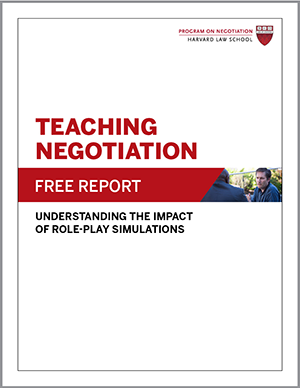
In an effort to encourage students to be creative and learn from negotiation examples, Jim Lawrence, a long-time PON contributor, simulation author, attorney and practicing mediator with Frost Brown Todd LLC, likes to grade “those aspects of the simulation which the student controls and which are less, if not at all, dependent on the shared outcome of the exercise.” Whether to grade student role-play performance, process and outcomes is a tricky question. Jim shared his thoughts on the value and purpose of grading students participating in negotiation simulations.
“If graded, students may opt for a more dependable strategy to get a higher grade rather than experiment with new strategies that they have not tested. Grading, on the other hand, permits an objective determination of a student’s ability to achieve a good outcome.”
Here are some negotiation examples of how he applies his grading process to role-play simulations that PON sells through the Teaching Negotiation Resource Center (TNRC).
Grading a Student’s Negotiation Ethics
Many disputes involve real or perceived moral transgressions and parties often disagree about the details of the negotiation. Examples such as questionable ethical behavior can escalate tension and create an emotionally volatile discussion.
Bullard Houses
A two-party, multi-issue real estate negotiation exercise between representatives for a buyer and seller.
In this TNRC favorite, Jim likes to focus on three points:
- Will a student stay within his client-given authority when it comes to crafting an agreement?
- Will a student mislead opposing counsel by agreeing to a certain level of confidentiality, and then break that trust?
- Will a student be bound by the ethical requirement of seeking client approval before agreeing to attorney-to-attorney confidentiality?
DONS Negotiation
A four-person, two-party, two-round negotiation between a former couple and their lawyers regarding the knowing transmission of DONS, a fatal disease communicated through sexual intercourse.
This is one of the TNRC’s challenging negotiation examples that features an ethical dilemma at its core. Here, Jim will deduct marks if:
- A student acting as a lawyer knowingly misrepresents material facts, despite their client’s endorsement to deceive the other party.
- It becomes apparent that a student is unable to tell material from immaterial fact.
- If full, partial and misleading disclosure options are mishandled in the context of ethical and professional rules of conduct and common law fraud.
Teflex Products
A five-party, multi-issue negotiation among representatives of a pharmaceutical company, a medical drug manufacturer, and three consumer organizations over the delayed release of a new drug.
Jim’s students will receive higher grades if:
- The Chief Scientist or Pharmaceutical Company’s Representatives are truthful with the Consumer Group Representatives, or each other, about the reason why the new drug has not reached the market.
- They demonstrate observable, superior negotiation skills.
Grading Students’ Ability To Build A Working Relationship
When parties build a solid foundation for a business relationship at the outset of a negotiation, they give themselves a much better chance of arriving at a successful agreement. Jim stresses this fact to his students so they can focus on their internal and external relationships.
Chestnut Village
One of the TNRC’s multi-party, multi-issue negotiation examples between 3-4 construction company representatives and 5-6 neighborhood representatives over safety and nuisance complaints regarding a local construction project; internal team meetings precede external negotiations.
Students’ grades will suffer if:
- They are unable to build collaborative working relationships in their internal groups: the four-person construction crew or seven-person group of village residents.
- The negotiating groups cannot maintain their own internal working relationships, while also building new coalitions with their negotiation counterparts across the table.
MAPO – Administration Negotiation
A two-team, multi-issue collective bargaining negotiation examples between three police union representatives and three municipal representatives over police salaries, benefits, and working conditions.
Jim’s participants walk away with a better mark when they:
- Engage in an open and honest dialogue with their negotiation teammates in an effort to unearth important interests.
- Foster a collaborative environment with their opposition, thus creating a space to explore creative options.
How To Construct A Grade
During a 13-week term, Jim and his two TAs continuously observe the various groups in their class and note the group dynamic and individual contributions.
When grading his students Jim generally assigns each member of a successful team one point. Students can also gain another point, or lose a point, depending on their actions during the negotiation. For example, superior negotiation skills will earn students an extra point: an ethical infraction would cost a student one point. Over a term, six or more points will earn an A, five points an A-, four points a B+, etc.
Participation comprises 33% of the student’s overall grade. For class participation alone, students receive a minimum “B-“ which assumes they are always present in class but remain quiet and unremarkable.
The remaining 67% of the student’s overall grade is assigned to a final journal, which contains reflection and self-analysis on the supplemental readings, concepts discussed in class, and the student’s negotiation activity. In particular, Jim looks to the journal for:
- What students thought worked well?
- What surprises they might have encountered?
- How did they deal with those unexpected issues?
- What would they do differently next time?
Jim does not penalize students for experimenting with negotiation techniques regardless of whether those experiments are successful or not. However, he holds his class accountable for their actions on an ethical and inter-personal level. The resulting grades allow students to develop their own unique negotiation approach while understanding the importance of good process and ethical behavior.
James K. Lawrence is the author of the following role-play simulations available through the TNRC:
- John & Mary – Mediation Role Play
- Welding Connection (with co-author Marjorie Corman Aaron) – Mediation Role Play
- Leaves Before the Fall – Negotiation Role Play
- Teflex Products (co-authored Teaching Note with Lawrence Susskind) – Negotiation Role Play
What do you think of these negotiation examples? Share your thoughts in the comments.
Originally published in 2014.





